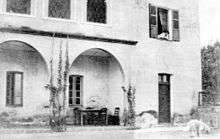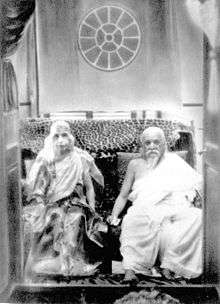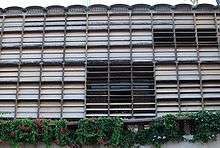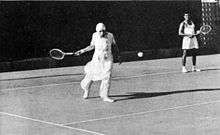Mirra Alfassa
| Mirra Alfassa | |
|---|---|
.jpg) Mirra Alfassa | |
| Institute |
Sri Aurobindo Ashram Auroville |
| Pen name | The Mother |
| Personal | |
| Born |
Blanche Rachel Mirra Alfassa 21 February 1878 Paris, France |
| Died | 17 November 1973 (aged 95) |
| Resting place | Pondicherry, India |
| Religious career | |
| Students | Satprem, Nolini Kanta Gupta, Nirodbaran, Amal Kiran, Pavitra |
| Works | Prayers And Meditations, Words of Long Ago, On Thoughts and Aphorisms, Words of the Mother |
| Signature |
 |
Mirra Alfassa (21 February 1878 – 17 November 1973), known to her followers as The Mother, was the spiritual collaborator of Sri Aurobindo. Her full name at birth was Blanche Rachel Mirra Alfassa.[1]
She came to Sri Aurobindo’s spiritual retreat on 29 March 1914 in Pondicherry, India. Having to leave Pondicherry during World War I, she spent most of her time in Japan where she met poet Rabindranath Tagore. Finally she returned to Pondicherry and settled there in 1920. After 24 November 1926, when Sri Aurobindo retired into seclusion, she founded her ashram (Sri Aurobindo Ashram), with a handful of disciples. She became the spiritual guide of the community.
The experiences of the last thirty years of Alfassa’s life were captured in the 13-volume work The Agenda. Sri Aurobindo considered her an incarnation of the Mother Divine and called her by that name: “The Mother”.
Early life
Childhood

Mirra Alfassa was born on 1878 in Paris to Moïse Maurice Alfassa a Turkish Jew father, and Mathilde Ismalun an Egyptian Jewish mother, a bourgeoisie family. She had an elder brother named Mattéo Mathieu Maurice Alfassa, who is later known to have held numerous French governmental posts in Africa. The family had just migrated to France, an year before she was born, the marriage fell apart and both Mathilde and Maurice were living separate lives at 62 Boulevard Haussmann in Paris, Mirra was close to her grandmother Mira Ismalum (née Pinto), who was one of the first women to travel outside Egypt alone and was also a neighbour.[2][3]
Mirra had learnt to read at the age of seven and joined school very late at the age of nine; she is believed to have held interest in various fields of art, tennis, singing, etc. and was a concern to her mother who saw lack of apparent deeper, permanent concern over any matter in Mirra.[4] By the age of 14 she had become a good reader and had read most of the books in her father's collection, which is believed to have helped her achieve mastery over French.[5] Her biographer Vrekhem notes that Mirra had various occult experiences in her childhood but knew nothing of the subject and their relevance, she kept these experiences to herself and did not share with anyone as her mother was believed to be atheist and any experiences were deemed to be a mental problem which had to be treated.[6] Mirra especially recalls at the age of thirteen or fourteen having a dream of a dark figure which she used to call as Krishna whom she had never seen before in real life.[7][8][9]
As an Artist & Traveller

In Paris
In 1893 after graduating from school, she joined Académie Julian[10][11]to study art. Her grandmother Mira introduced her to Henri Morisset who was an ex-student of the Académie; they were married on 13 October 1897.[12] Both were well off and worked as artists for the next ten years, during an era known for having many impressionist artists. Her son André was born on 23 August 1898. Some of her paintings were accepted by the jury of Salon d'Automne and were exhibited in 1903, 1904 and 1905.[13] She recalls herself being a complete Atheist at this time and was against any religious claim on the existence of God, but was experiencing various memories which she found were not mental formations but were spontaneous experiences and never revealed this to anybody in her surroundings. She had developed an urge to know about such experiences and found Raja yoga by Swami Vivekananda was able to explain something about her experiences. She received a copy of loose translation of Bhagavad Gita in French which helped her a lot in learning about these experiences.[14]
Max Théon & Alma Théon

During this time Mirra made the acquaintance of Louis Thémanlys who was the head of the Cosmic Movement, a group started by Max Théon through a copy of Cosmic Review, she attended the speeched given by Louis and became active in the group, for the first time on 14 July 1906 she journeyed alone to Algerian city of Tlemcen to meet with Max Théon and his wife Alma Théon, she consequently travelled twice in 1906 and 1907 to their home at Tlemcen and in their house practised and experimented on teachings of Max Théon & Alma Théon. [15]
Alfassa and Henri separated in 1908, and Alfassa then moved to 49 Rue des Lévis, Paris, it was a small apartment and she was living alone and involved herself with discussion and talking with Budhhists and other cosmic movement circles. During this time she also grew her acquaintance with Madame David Néel.[16] Mirra married Paul Richard in 1911 who after serving four years in army had involved himself in philosophy & theology, he had come to know Mirra when he was in talkings with Max Théon, Vrekhem a biographer of Mirra informs that Richard was undergoing a legal problem in inheriting kids from his first marriage to a Dutch woman and had asked Mirra for help and she had accepted this.[17]
First visit to Pondicherry and Japan

Richard was also an aspiring politician and had attempted to elect himself to the French senate from Pondicherry which was then under French control. Despite his initial failure he wanted to try it once more and on 7 March 1914 Mirra along with Richard set sail to India and reached Pondicherry India by 29 March.[18][19] After reaching Pondicherry both had fixed an appointment with Sri Aurobindo who was then settled in Pondicherry and had suspended all his activity for Indian independence from British rule. During her first meeting Mirra recalls the person whom she used to see in dreams was none other than Sri Aurobindo. She is supposed to have felt sudden silence in presence of Aurobindo and no thought entered her mind.[20]
Richard lost the elections to Paul Bluysen to whom he had supported in previous elections. Both Richard and Mirra were running out of money and decided to publish a review on yoga of Sri Aurobindo called Arya in both English and French. The Journal was first published on 15 August 1914 and ran for next six and half years, consequently journals published were later made into complete books.[21] By this time World War I had erupted and Indian revolutionaries were being prosecuted by British for being spies of German army, Even though Aurobindo had totally dispensed his activities against British rule he was considered unsafe and all the revolutionaries were asked to move to Algeria, Aurobindo had refused this offer, so the British had written to French government in Paris to hand over revolutionaries staying at French Pondicherry. This file came over to Mattéo Alfassa (brother of Mirra), who by then was foreign minister and put the file under other working files never to be looked upon again.[22] [23]
On the insistence of the British in 1915, Richard was ordered to move out of Pondicherry; after an unsuccessful attempt to stay both Mirra and Richard left for Paris on 22 February 1915. After few years Richard was ordered to promote French trade in Japan (who was then an ally of France and Britain) & China. Mirra left for Japan along with Richard, never to return to Paris again.[24]
Mirra along with Richard stayed in Japan and had acquaintances with Indian community. Their in Japan time was relatively peaceful, with the result that they spent the following four years there and only on 24 April 1920 did Mirra return with Richard to Pondicherry.[25][26] accompanied by Dorothy Hodgson. she moved to live near Aurobindo in the Guest House at Rue François Martin. Richard did not stay long; he spent a year traveling around North India (Das 1978 p. 209) returning to France and remarried in England after divorcing Mirra. After working few years as a professor in United States he died in 1968.[27] on November 24, 1920 due to heavy storm and rain Sri Aurobindo asked Mirra and Dorothy Hodgson (Later come be known as Dutta) to be moved into Sri Aurobindo´s house and she started living along with other inmates in the house. [28] .[29]
Ashram foundation
| Integral yoga | |
|---|---|
 Henri Cartier-Bresson's photo of Sri Aurobindo and Mirra as "the Mother" |
With time many influenced by the Arya Magazine and others who had heard about Sri Aurobindo started to come to his residence either permanently to reside or practise Sri Aurobindo´s yoga . Mirra was initially not totally accepted by other inmates of the house and was considered outsider. Sri Aurobindo considered her to be of equal yogic stature and started calling her as "The mother", and was later known to all inmates as "the mother" from then on. Around 1924 onwards the mother was started to organise the functioning of the inmates and slowly the house was turning into a Ashram with many followers flowing in every day.[30] After 1926 Sri Aurobindo started to retire from regular activities towards yogic practises and number of inmates had grown to 85 members by then the group had slowly turned into a Ashram.
Integral yoga & The Siddhi Day
On November 24, 1926 later declared as Siddhi day (victory day) and still celebrated by Sri Aurobindo Ashram [31] as Mirra and Aurobindo claimed that overmind Consciousness had manifested directly on earth allowing the possibility for Human consciousness to be directly aware and be in the overmind consciousness[note 1]. Sri Aurobindo had received few complains against Mirra on daily running of Ashram, to settle this matter through a letter from April 1930 Sri Aurobindo declared mother to be sole in charge of further activities of the ashram.,[32] by 23 August 1930 Mother notes that the ashram members had grown up to to 80 to 100 inmates, a self sustaining community with all basic amenities fulfilled [33] Sri Aurobindo and mothers work and principal of yoga called there way of yoga as Integral Yoga an all embracing yoga, a variance with older ways of yoga where in the follower would not give up once life and living to live in a monastery but would be present in regular life but seeking spirituality in all parts of life. [34]

By 1937 the ashram inmates had grown to more than 150 and there was need for expansion of building and facilities, helped by Diwan Hyder Ali, the Nizam of Hyderabad had made a grant to the ashram for further expansion, under the guidance of Mirra, Antonin Raymond as the chief architect assisted by Franticek Sammer and George Nakashima, a dormitory building was constructed, by this time second world war erupted delaying the construction and finally being completed after ten years of starting was called Golconde.[35] In 1938 Margaret Woodrow Wilson, the daughter of US President Woodrow Wilson, came to the Ashram and chose to remain there for the rest of her life.[36]
By 1939 world war had broken out even though some of the members of Ashram supported Hitler indirectly and were happy that the Britain was attacked both Mirra and Sri Aurobindo publicly declared there support the Allied forces by donating to Viceroy‘s war fund, much to the surprise of many Indians Sri Aurobindo & Mirra had supported Allied forces and found that Allied forces stood for revolutionary forces would keep open for the evolutionary forces and the victory of Axis powers would drag back humanity, degrading it, eventually leading into failure as a race.[37]
School in Ashram & death of Sri Aurobindo
on 2nd of December 1943 Mirra started a school for about twenty children inside ashram, she considered this was a considerable movement away from life in the ashram which was strict till then totally renouncing outside world, but found this as eventuality of the principal of Integral yoga i.e "all life is Yoga".[38] The school later became to known as Sri Aurobindo International Centre of Education.



After Sri Aurobindo's death in 1950,[39] from 1960 till her own death in 1973, Alfassa regularly met her disciple Satprem, with the content of three conversations published in French and English in the 13-volume book The Agenda.
From 1962, she continued to give public Darshans four times a year from an upstairs balcony, at which thousands of devotees gathered.[40] Her religious experiences have intensified through the later 1960s and 1970s.
In 1956 she established the Sri Aurobindo Ashram, Delhi Branch, together with Surendranath Jauhar, and Mother's International School. In 1967 plans were made and land acquired to found a city of spiritual seekers in Gujarat, which she named Ompuri. In 1968 Alfassa founded Auroville.
After Mirra Alfassa died on 17 November 1973, her body was placed in the newly constructed Samadhi structure: a vault in the courtyard of the Ashram where Sri Aurobindo’s body had been placed in 1950.[41]
Auroville
In the 1968, Alfassa helped create Auroville, a model universal township with a view to enhance the forces of evolution and to initiate a new renaissance in India and the world. At present, in 2015, Auroville is more of a large spread out community with a population of 2500 people from fifty countries. However, planning and development undercurrents are for outgrowing the present stage and emerge as a unique town envisioned by Alfassa.
Notes
- ↑ A detailed description of the Overmind is provided in Book I ch.28, and Book II ch.26, of Sri Aurobindo's philosophical opus The Life Divine
References
Notes
Citations
- ↑ Archives Départementales de Paris en ligne , acte de naissance n° 1878/390/9e du 21/02/1878, page 6
- ↑ Vrekhem (2004), pp. 4-7
- ↑ Mother's Chronicles Bk I; Mother on Herself – Chronology p.83.
- ↑ Vrekhem (2004), pp. 8
- ↑ Vrekhem (2004), pp. 10
- ↑ Vrekhem (2004), pp. 11-13
- ↑ Vrekhem (2004), pp. 14
- ↑ Bulletin of the Aurobindo Center of Education, 1976 p.14, Mother on Herself pp.17–18.
- ↑ Bulletin 1974 p.63.
- ↑ "The Mother". sriaurobindoashram.org. 2013. Retrieved 11 March 2013.
- ↑ Mirra Alfassa, paintings and drawings, P. 157-158
- ↑ Vrekhem (2004), pp. 15-20
- ↑ Vrekhem (2004), pp. 24
- ↑ Vrekhem (2004), pp. 29
- ↑ Vrekhem (2004), pp. 37-67
- ↑ Vrekhem (2004), pp. 73-75
- ↑ Vrekhem (2004), pp. 84
- ↑ Interview with Prithwindra Mukherjee, The Sunday Standard, 15 June 1969; The Mother by Prema Nandakumar, National Book Trust, 1977, p9.
- ↑ Karmayogi no date, Van Vrekhem 2001.
- ↑ Vrekhem (2004), pp. 140-155
- ↑ Vrekhem (2004), pp. 160-172
- ↑ Vrekhem (2004), pp. 175-177
- ↑ Purani 1982 pp.9–12
- ↑ Vrekhem (2004), pp. 178-180
- ↑ Iyengar 1978 p.182
- ↑ Coll. Works vol 8, pp.106–7
- ↑ Vrekhem (2004), pp. 215-216
- ↑ Vrekhem (2004), p. 225
- ↑ Agenda vol.2 pp.371–372
- ↑ Vrekhem (2004), pp. 228-248
- ↑ Vrekhem (2004), pp. 250-251
- ↑ Vrekhem (2004), pp. 258-259
- ↑ Vrekhem (2004), pp. 286-287
- ↑ Vrekhem (2004), pp. 270-271
- ↑ Vrekhem (2004), pp. 303-305
- ↑ Nirodbaran 1972, Karmayogi
- ↑ Vrekhem (2004), pp. 310-326
- ↑ Vrekhem (2004), pp. 334-335
- ↑ Volume 11, Notes on the Way, p. 328 20 December 1972
- ↑ Collected Works, vol. 11; Satprem 1982
- ↑ Mother on Herself – Chronology p.83
Bibliography
- Heehs, Peter (2008), The Lives of Sri Aurobindo, Columbia University Press, ISBN 0-231-14098-3
- Vrekhem, Georges Van (2004), the Mother the story of her life, Rupa & Co, ISBN 8129105934
- Jones, Constance; Ryan, James D., eds. (2007), Encyclopedia of Hinduism, New York: Facts on File Inc, ISBN 0-8160-5458-4
Further reading
- Anon., The Mother – Some dates
- Aurobindo Ghose (1972), Collected Works of Sri Aurobindo, Sri Aurobindo Ashram, Pondicherry, Birth Centenary Edition
- (1972b) The Mother, Sri Aurobindo Ashram, Pondicherry
- Iyengar, K.R.S. (1978), On the Mother: the chronicle of a manifestation and a ministry (2 vols, continuously paginated), Pondicherry, 1978 (2nd ed)
- Alfassa, Mirra (1977) The Mother on Herself, Sri Aurobindo Ashram, Pondicherry
- (1978) Collected Works of the Mother, Sri Aurobindo Ashram, Pondicherry Centenary Edition (17 vol set)
- (1979– ) Mother's Agenda (Engl. transl) Institute for Evolutionary Research, New York, NY (13 vol set)
- (date?) Flowers and Their Messages, Sri Aurobindo Ashram
- (date?) Flowers and Their Spiritual Significance, Sri Aurobindo Ashram
- Das, Nolima ed., (1978) Glimpses of the Mother's Life vol.1, Sri Aurobindo Ashram, Pondicherry
- Mukherjee, Prithwindra (2000), Sri Aurobindo: Biographie, Desclée de Brouwer, Paris
- Nahar, Sujata (1986) Mother's chronicles Bk. 2. Mirra the Artist, Paris: Institut de Recherches Evolutives, Paris & Mira Aditi, Mysore.
- (1989) Mother's chronicles Bk. 3. Mirra the Occultist. Paris: Institut de Recherches Evolutives, Paris & Mira Aditi, Mysore.
- Satprem (1982) The Mind of the Cells (transl by Francine Mahak & Luc Venet) Institute for Evolutionary Research, New York, NY
- Van Vrekhem, Georges: The Mother – The Story of Her Life, Harper Collins Publishers India, New Delhi 2000, ISBN 81-7223-416-3 (see also Mother meets Sri Aurobindo – An excerpt from this book)
- Van Vrekhem, Georges: Beyond Man – The Life and Work of Sri Aurobindo and The Mother, HarperCollins Publishers India, New Delhi 1999, ISBN 81-7223-327-2
Partial bibliography
- Commentaries on the Dhammapada, Lotus Press, Twin Lakes, WI 2004, ISBN 0-940985-25-X
- Flowers and Their Messages, Lotus Press, Twin Lakes, WI ISBN 0-941524-68-X
- Search for the Soul in Everyday Living, Lotus Press, Twin Lakes, WI ISBN 0-941524-57-4
- Soul and Its Powers, Lotus Press, Twin Lakes, WI ISBN 0-941524-67-1
External links
| Wikimedia Commons has media related to Mirra Alfassa. |
| Wikiquote has quotations related to: Mirra Alfassa |